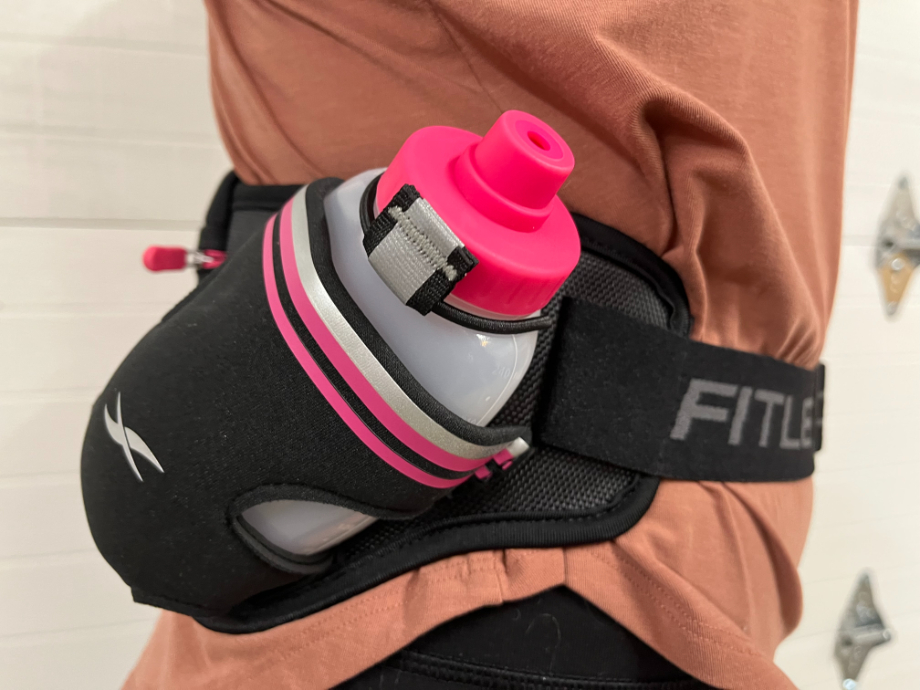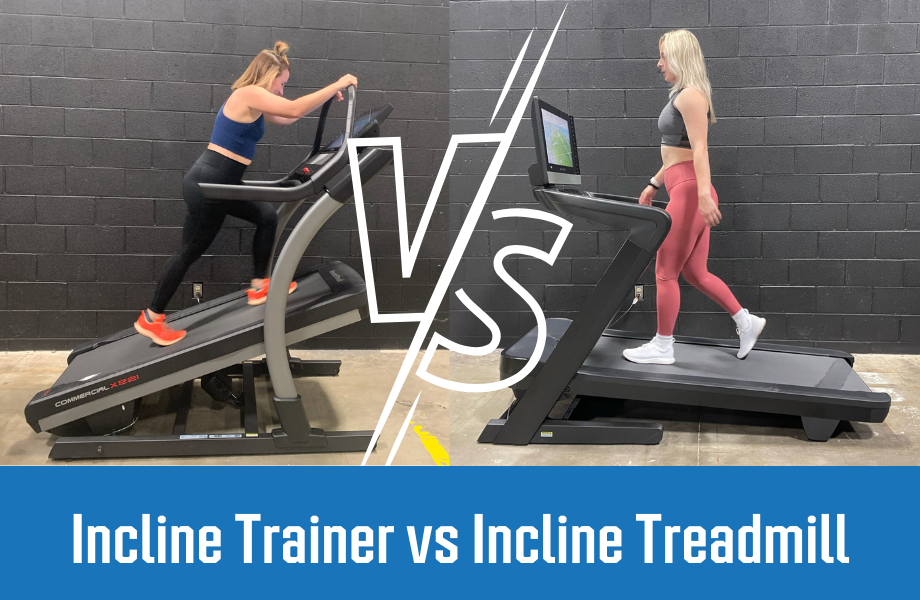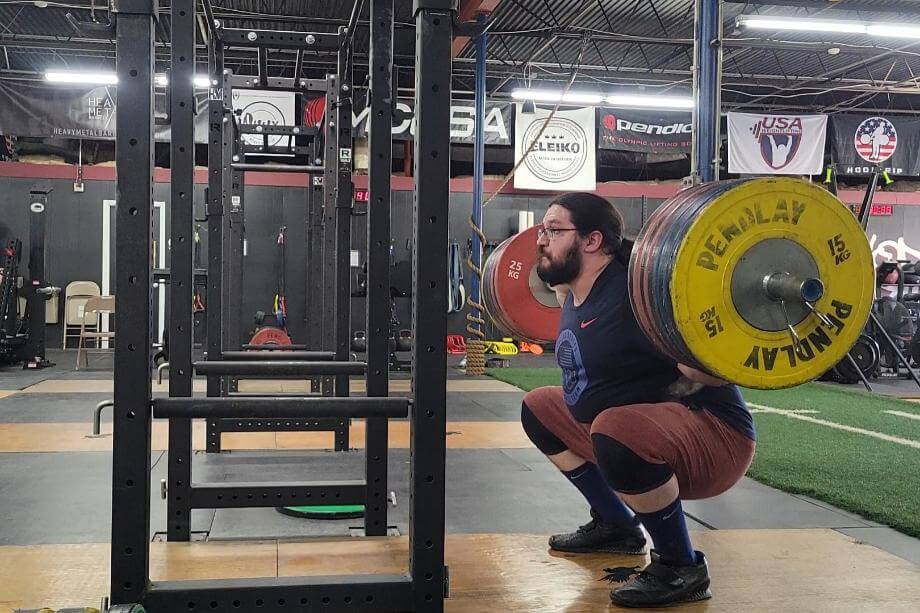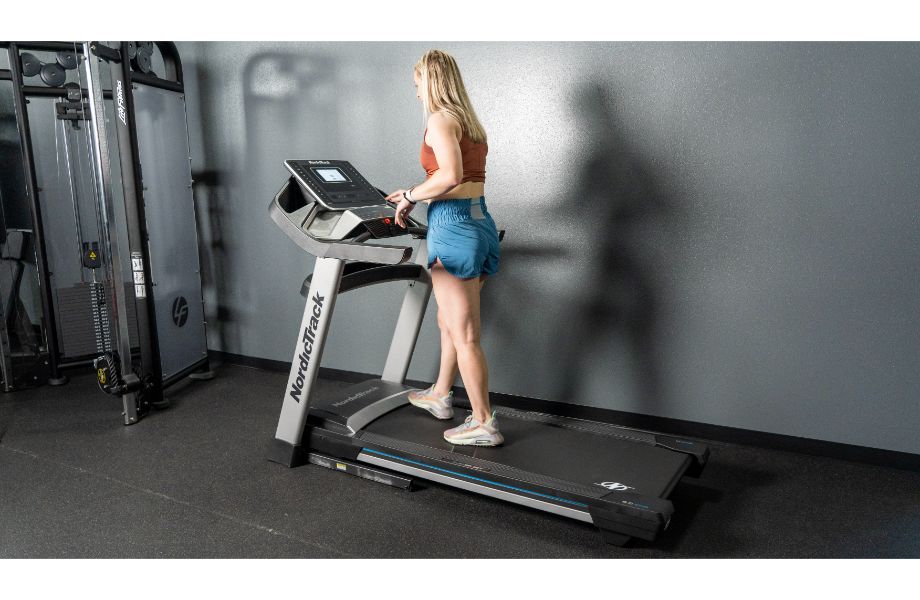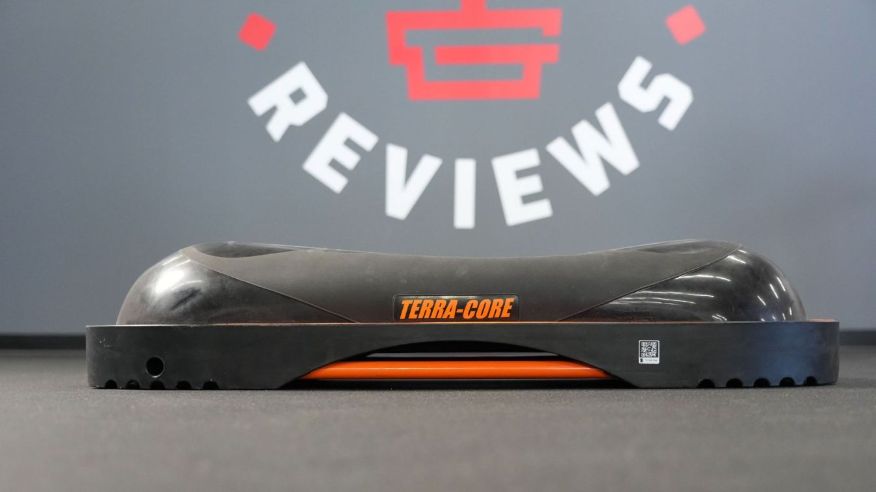Running belts don’t get as much attention as the best running shoes or the best workout leggings, but once you wear one, you may never go back. The best running belts and waistpacks accommodate all your essentials, from your phone to your keys, without affecting your stride or adding a lot of bulk to your waist.
Unfortunately, if you don’t find the right fit, you’ll be dealing with incessant bouncing, shifting, and probably chafing. No, thanks!
If you’re new to running belts, or you’re searching for the right one, we’re here to help. Avid runners and GGR writers and experts Amanda Capritto, Lauren Strong, Anthony O’Reilly, and Nicole Davis (who are also all certified personal trainers), spent several weeks testing almost two dozen models in every kind of design, from the best running belts with water bottles, to a stretchy minimalist band, to a fanny pack style with a fully functioning phone pocket. We took them on rugged trail runs and more leisurely dog walks to narrow it down to this list of our favorites.
For each running belt, our expert product testers looked at features such as:
- Price
- Adjustability and fit
- Materials
- Storage capacity
- Performance
Best Running Belts in 2025
- Best Overall Running Belt: Nathan TrailMix Plus Hydration Belt
- Best Running Belt for Storage: SPIBelt Distance Pro
- Best Budget Running Belt: Fitletic Hydra 16 Hydration Belt
- Best Reflective Running Belt: Reflective SPIBelt Original
- Best Running Belt for Smartphones: Sporteer Kinetic K1 Running Belt Waist Pack
- Best Minimalist Running Belt: Naked Running Band
- Best for Running with Dogs: iYoShop Hands Free Dog Leash
- Best Hydration Running Belt: Amphipod Profile-Lite High-Five K-Pack
Best Running Belt Overall: Nathan TrailMix Plus Hydration Belt
Good for: Anyone that wants a good running vest that’s not too bulky
Best Running Belt Overall
Nathan TrailMix Plus Hydration Belt
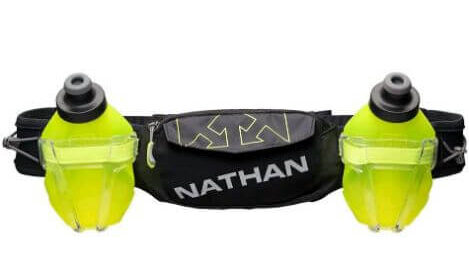
Product Highlights
- Nathan’s best selling running belt with reflective details
- Compatible with most large-format phones
- Included: Running belt and 210 oz water bottles
Pros & Cons
Pros
- 60-day satisfaction guarantee
- 1-handed access to storage
- Great customer service
Cons
- 1 size fits most
- Elastic holding water bottles wears quickly
- Many customers prefer older version
Bottom Line
The Nathan TrailMix Plus Hydration Belt can cover all your running needs, but many customers prefer the older model.
The Nathan TrailMix Plus Hydration Belt has everything you could want in a hydration belt for running. There’s a zippered pocket in front that’s big enough to hold an iPhone, plus a mesh pouch with a Velcro closure that fits keys, credit cards, and a snack for some running fuel. There are also two secure holsters near each hip that come with 10-ounce flasks for quick access to hydration.
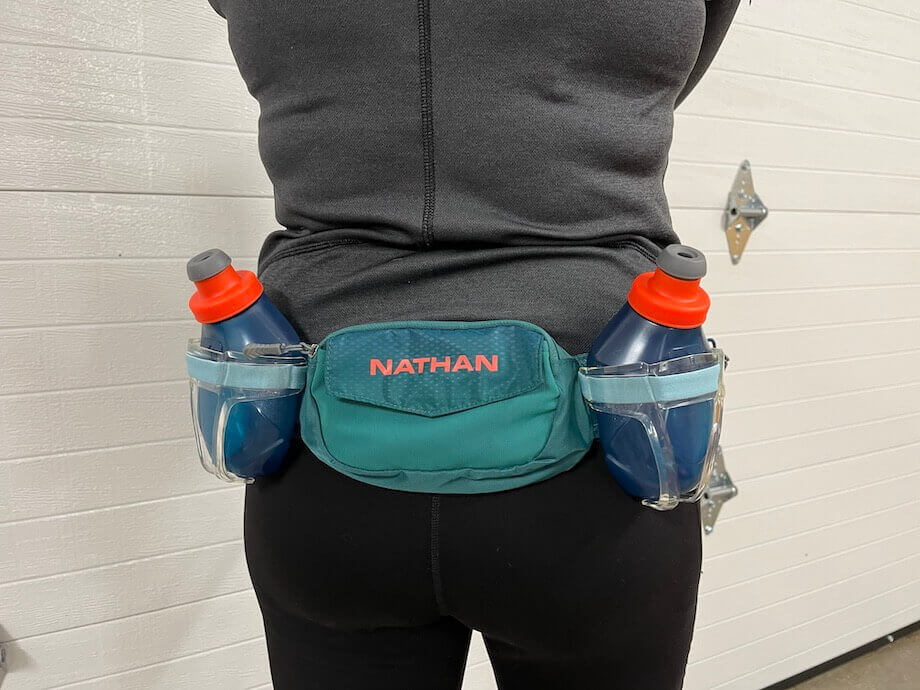
This belt only comes in one size, which we don’t like, but it has a snap closure and adjustable straps that ensure a secure fit on most body types. Two shock cords wrap around the bulk of the belt, with a tension lock that lets you tighten it more than the strap adjustments allow.
There’s some stretch throughout the waistband and behind the water bottle holsters, which Lauren Strong, CPT and GGR senior writer, says made the fit feel awesome. She thinks the design itself “looks a little dorky,” but its performance outweighs any concerns there.
“I thought the little water bottles on either side of the hips would feel weird but they didn’t! This has a totally secure fit; it’s comfortable, and there’s no bounce!” she says excitedly.
The mesh that runs through the back also makes the belt really breathable, so it doesn’t trap heat where it sits on your body. There’s also some reflective details for added safety during low-light runs.
| Material | 60% nylon, 40% polyester |
| Weight | 9.1 oz |
| Sizes | One size fits most |
Best Running Belt for Storage: SPIBelt Distance Pro
Good for: carrying extra essentials when you’re running lots of miles
Best for Long-Distance Runners
SPI Distance Pro
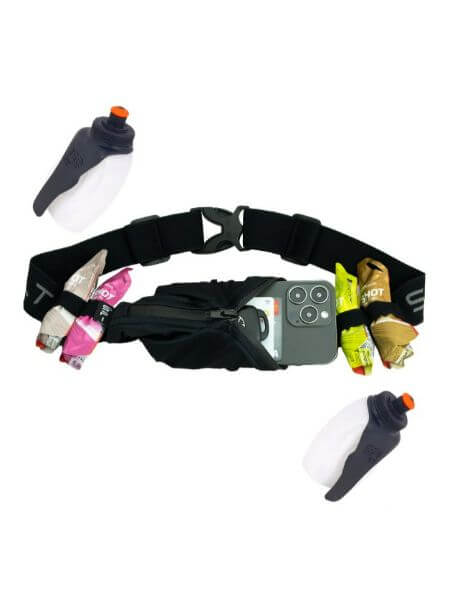
Product Highlights
- Bounce-free belt
- 4 loops for energy gels
- Compatible with all phones including larger models
- Included: belt with 2 SPI H2O Companion bottles
Pros & Cons
Pros
- Compatible with all phones
- Running belt and 2 water bottles
- 4 loops for energy gels
- Free shipping within USA
- Made in USA
- 1-year warranty
Cons
- Hand wash and hang dry
- Only 1 size available
- Reviewers note difficulty fitting larger phones in pocket
- Contains dry natural rubber, which may irritate people with a latex allergy
Bottom Line
The SPI Distance Pro is a solid exercise belt if you’re looking for something to hold your belongings, that doesn’t bounce, and can assist you with your hydration.
The SPIBelt Distance Pro can accommodate everything you need for long runs without weighing you down. It has a 9-inch zippered, weather-resistant pocket in the front that’s big enough for a large phone and some other valuables, plus four external loops for energy gels. Talk about easy access.
There’s a stretchy pocket that can expand when needed, but stays flat when it’s not full. Nicole Davis, CPT and GGR head of content, says that while it’s secure, you wouldn’t be able to remove it mid-run unless you make a full pitstop (so you might want to make sure you have a pair of the best running headphones with touch controls for music and phone calls).
This is a great running belt for marathon distances because it also comes with clip-on, removable water bottles, which is a nice touch. Nicole says it’s not really a hydration belt—it still has a minimalist design that won’t get in your way, just with the added benefit of water right by your side.
The band itself is elastic, so it has a snug fit that’s still comfortable and bounce-free. There’s also a clip in the back and the straps are adjustable, so you can tighten it as needed. As is, it accommodates waist sizes from 27 to 48 inches, but there’s also an extender available if you need it to be bigger than that.
| Material | Elastic |
| Weight | N/A |
| Sizes | One size fits mosts (27-48 in) |
Best Budget Running Belt: Fitletic Hydra 16 Hydration Belt
Good for: Those who need a belt with an affordable price tag
Best Budget Running Belt
Fitletic Hydra 16 Running Belt
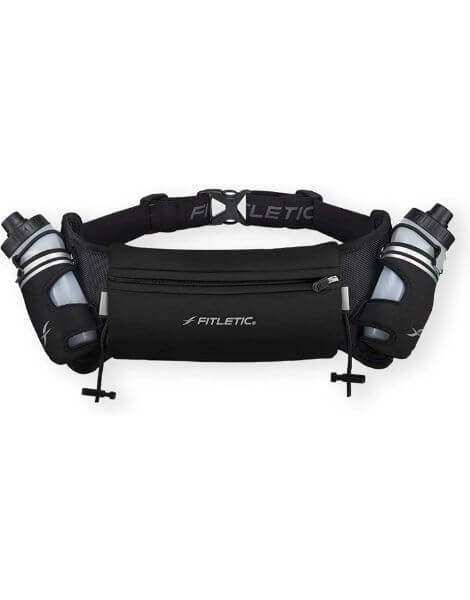
Product Highlights
- Patented hydration, running, and marathon belt
- Integrated bib toggles
- Included: Belt, two 8-oz water bottles
Pros & Cons
Pros
- Silicone grippers
- Integrated bib toggles
- Available in multiple sizes
Cons
- Some reviewers’ arms hit the bottles when running/walking
- Users had difficulty fitting large phones
- Zipper may fail
Bottom Line
The Fitletic Ultimate Hydra 16 Hydration Belt is popular with its users for providing storage for essentials, hydration, and gel storage. You may not be able to fit your larger phone, especially if you use a bulky case.
The Fitletic Hydra 16 has a great design for those who want water bottles, loops for gels, and a zippered pocket—all for under $50. It comes with two 8-ounce water bottles that fit snugly on either size of the zippered pouch. It secures with a heavy-duty plastic buckle.
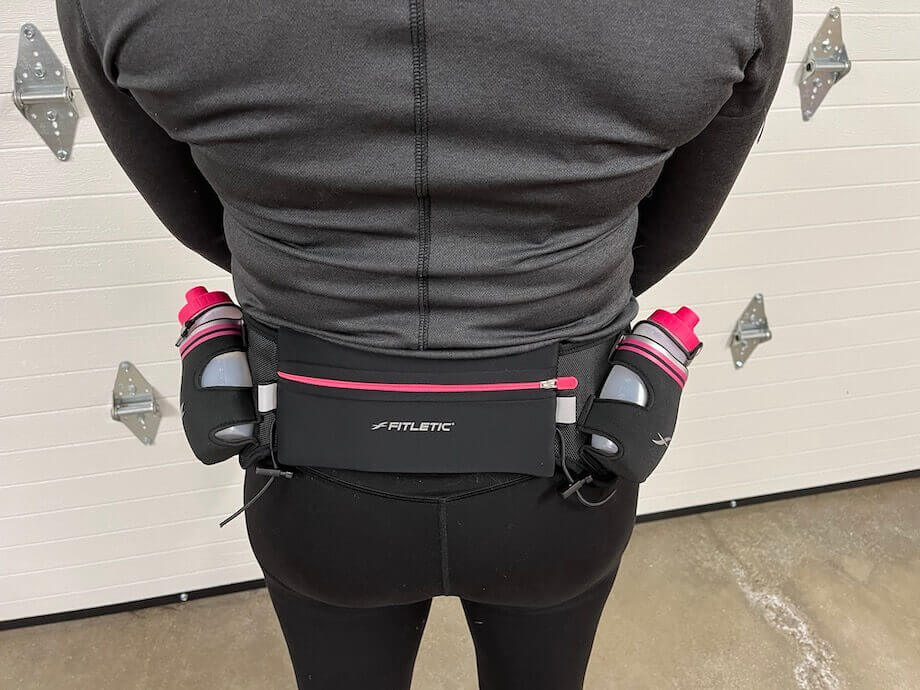
The belt comes in two sizes: a S/M that fits waists 24 to 34 inches, or a L/XL that fits waists 35 to 42 inches. Lauren Strong, CPT, GGR senior staff writer and running enthusiast, said the S/M belt set at its highest setting felt too snug on her—though by the measurements, it should have fit her just fine. Therefore, you may need to go a size up if you are concerned about having a belt that is too tight.
There are also a number of color options. In addition to basic black, you can choose from six styles that feature color highlights on the zipper, water bottle pouch, and water bottle lids.
| Material | 60% Polyester + 35% Nylon + 5% Spandex |
| Weight | 0.4 lbs |
| Sizes | S/M or L/XL |
Best Reflective Running Belt: Reflective SPIBelt Original
Good for: a little bit of storage and added reflectivity
Best Reflective Running Belt
SPIbelt Reflective Running Belt
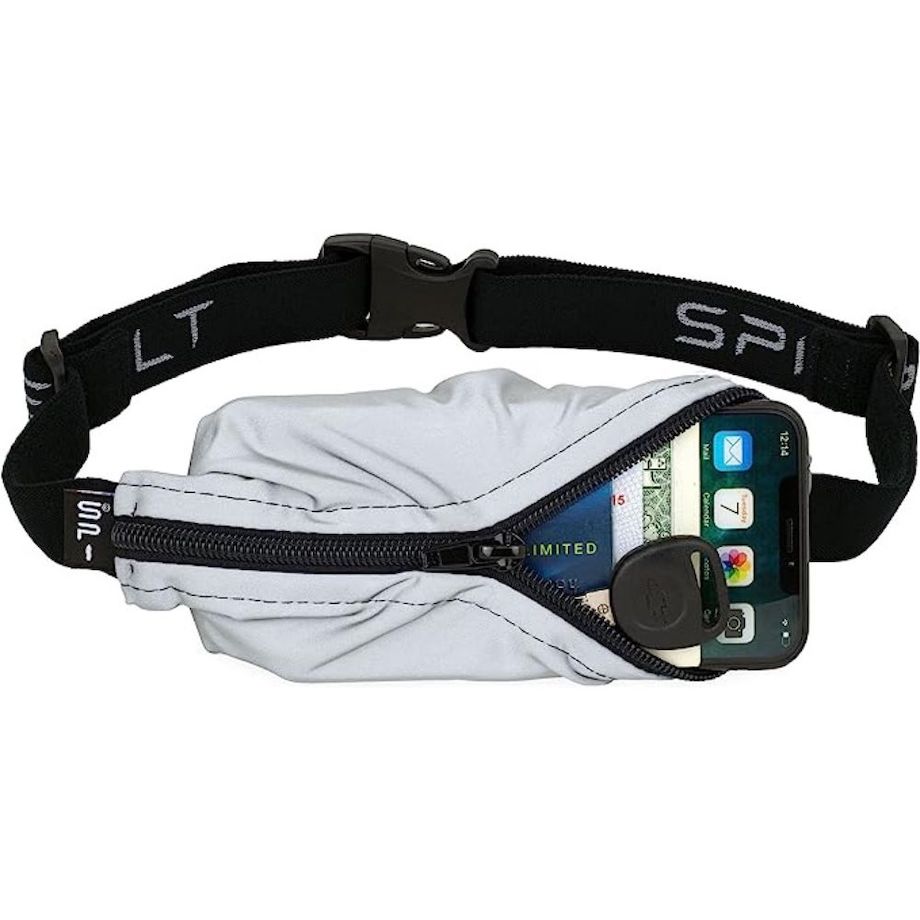
Product Highlights
- Reflective running belt with a large pocket and logo on the elastic waistband
- Zippered pocket securely holds smartphone and other small valuables
- Fits waist size 24–47 in
- The stretchy pocket expands to 9” x 4” x 2”
Pros & Cons
Pros
- Runners report that there is no bounce
- Lightweight
- Reflective
- Elastic waistband fit most
Cons
- Durability is questionable
Bottom Line
If you are looking for a bounce-free, comfortable, and secure running belt with reflective detail, the SPIbelt Reflective Running Belt is a solid choice.
Product tester Amanda Capritto is a fan of her SPIBelt (Small Personal Item Belt). She tested and used the brand’s reflective belt to assess its quality—and she is a fan, considering it a piece of the best reflective running gear.
“The entirety of the storage pocket is constructed of a reflective material that can increase the visibility of your person during low-light runs,” she says.
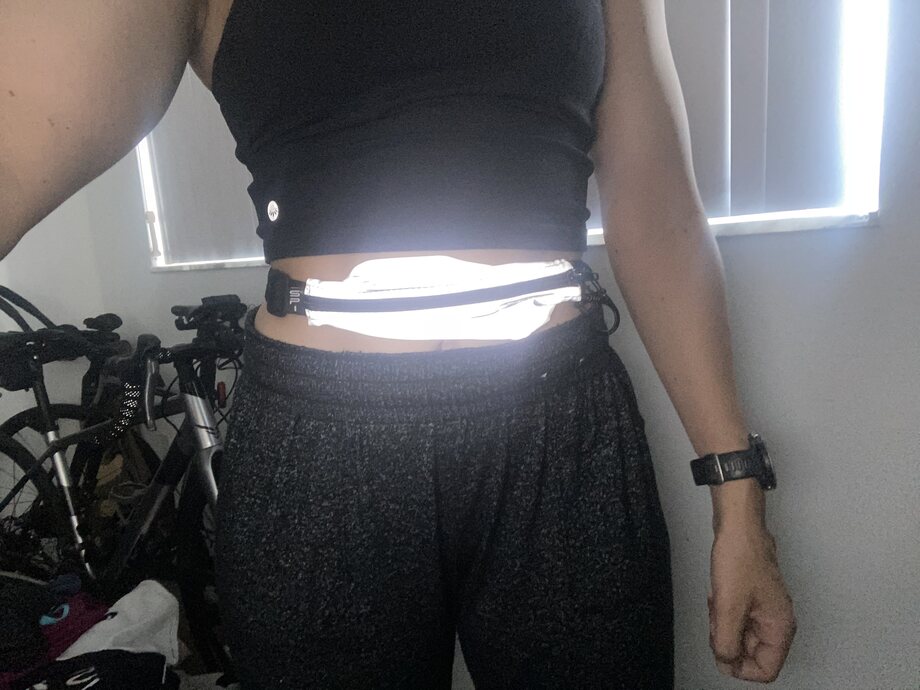
She notes that it is a good fit, adjusting to accommodate waists that are 24 to 47 inches. Additionally, she said the stretchy pocket fits most smartphones, including her own iPhone 13 Pro Max.
While this is reflective, Amanda warns that because it’s so small, it shouldn’t be the only piece of reflective equipment you are wearing if you are in the dark.
| Material | Soft elastic |
| Weight | 1.44 oz |
| Sizes | Fits waists 24″ to 47″ |
Best Running Belt for Smartphones: Sporteer Kinetic K1 Running Belt Waist Pack
Good for: anyone who wants to operate their phone during their run
Best for Smartphones
Sporteer Kinetic K1 Running Belt
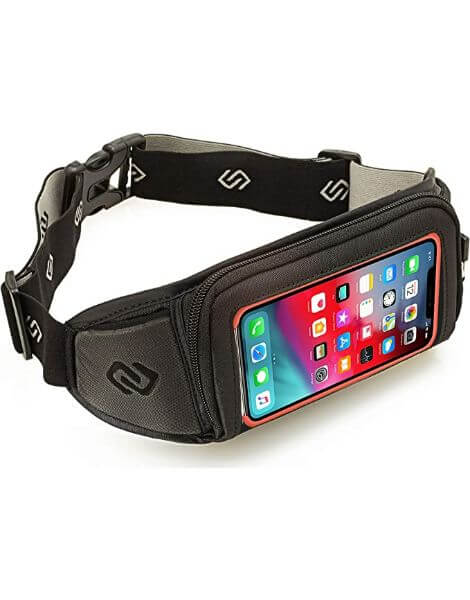
Product Highlights
- Running belt with clear touchscreen window
- Sweat resistant foam backing to keep phone dry
- Designed by athletes in the USA
Pros & Cons
Pros
- Clear touchscreen window
- Fits large phones with cases
- 1-year warranty
- 100% performance guarantee
Cons
- Users state the sample card leaves imprint on touchscreen window
- Elastic may stretch out with months of use
- Customers state the belt is bulky
Bottom Line
The Sporteer Kinetic K1 Running Belt is a good option if you have a large phone with a big case. You’ll also be able to access your phone mid-run without removing it from your belt.
Many running belts can accommodate smartphones, but you have to take your phone out to actually use it. Instead of a solid front pouch, the Sportneer Kinetic K1 waist belt has a large pocket in the front that can easily fit your phone with a rugged case, like an Otterbox, on it.
Not only that, the pocket also has a clear front that’s compatible with the touchscreen, so you don’t have to take your phone out to operate it. There’s a headphone opening at the bottom, so if you prefer a wired pair, you can connect to your phone while it’s securely in the pack.
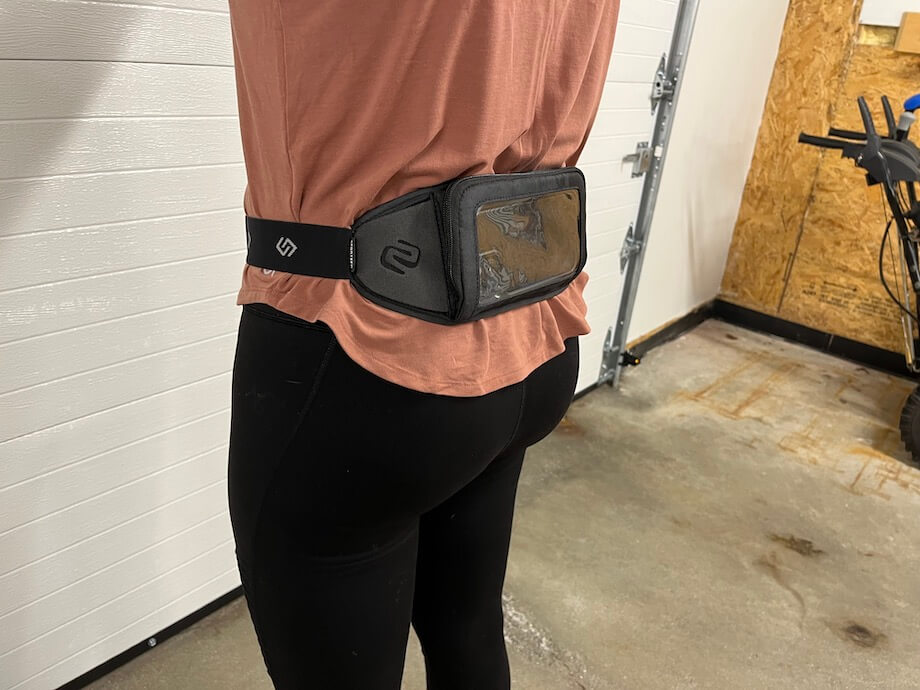
There’s a hidden pouch behind the phone pocket that can fit additional items, like your cash and some cards, plus two small pouches that can fit smaller items, like a key or earbuds. However, Lauren says she wouldn’t chance putting anything valuable in there because there’s no closure.
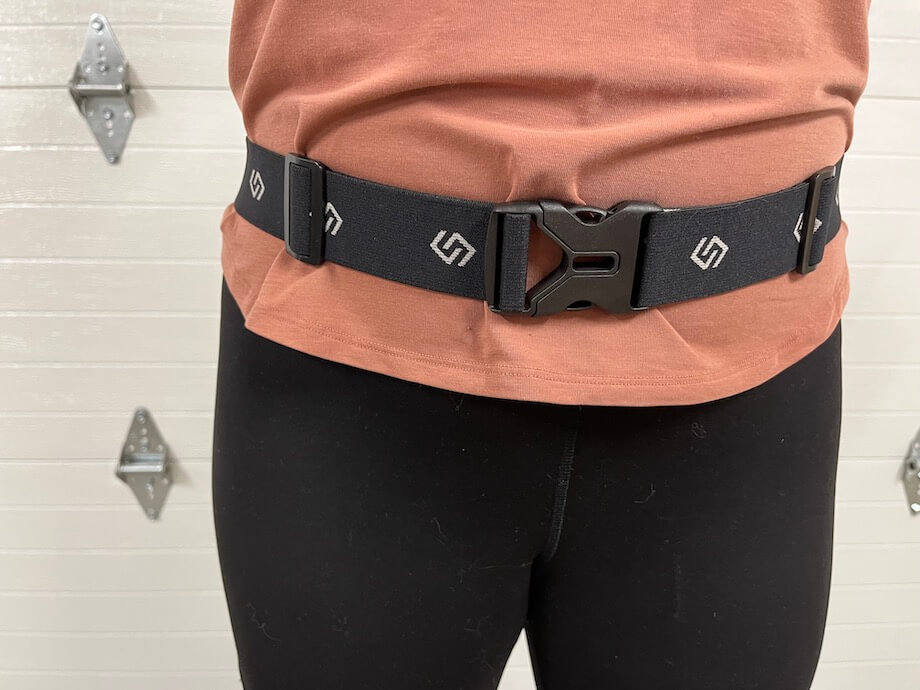
This running belt gets high marks for comfort, too. It has a fanny pack-like design, with an adjustable, elastic waistband that Lauren says has a huge amount of stretch. It felt glued to her body without being too tight or annoying, and had no bounce. There’s also a heavy-duty buckle in the back that makes it easy to take on and off.
While it’s not waterproof, the phone pouch does have a sweat-resistant foam backing. It also has spacer mesh to prevent chafing and hot spots, making it a great pick for the best running belt for phones.
| Material | Nylon |
| Weight | 3 oz |
| Sizes | One size fits most |
Best Minimalist Running Belt: Naked Running Band
Good for: anyone who wants a low-profile belt that can hold a lot
Best Minimalist
Naked Running Band
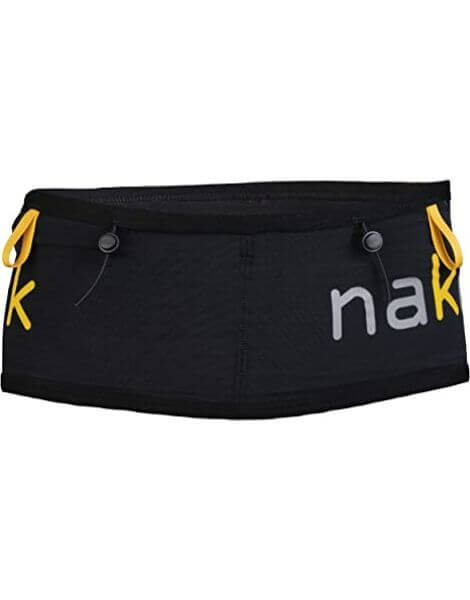
Product Highlights
- Waistband style running belt
- Reflective safety elements
- Exopower mesh
Pros & Cons
Pros
- 2-L capacity
- Race bib toggles
- Straps for storing trekking poles or rain shell
- Internal clip
- Holds larger phones
Cons
- Comparably expensive
- Not adjustable
- Large logo
Bottom Line
The Naked Running Band is a large capacity waistband-style running belt that people like for its comfort and ease of use.
If you prefer a low-profile running belt, the Naked Running Band is the one for you. It’s not your typical running belt—there are no closures or clasps of any kind. Instead, you slip it on like you’d put on a skirt and shimmy it up to your waist, according to Amanda Capritto, CPT, CNC, CES, CF-L1.
“It’s basically one large pocket (separated by a couple of vertical seams) and it securely holds quite a bit—my phone, key, doggy bags, and ID. It also has some external loops where I can hook my dog’s leash, which is nice, so I can go hands-free,” Amanda says.
The belt is super compressive, which is how it actually works; the compression between your body and the fabric is what secures everything in place. While this is really effective, it can be a little off-putting, especially if you just eaten prior to your run, according to Amanda. The trade-off is a completely bounce-free running belt though, so we think it’s worth it.
While there aren’t any bulky pocket or hydration pouches, it is wider than most. It’s about 5 inches wide, so it can cover a good amount of your stomach depending on your torso length. This isn’t really good or bad, just more of a “to consider.” The belt itself is made of a strong, breathable mesh so despite the fact that it may cover a large portion of your stomach, it still allows air flow and doesn’t create hot spots.
And despite its minimalist design, it has one of the largest capacities on the list and can accommodate more than two liters’ worth of your stuff.
| Material | Mesh |
| Weight | 2.3 oz |
| Sizes | One size fits most |
Best Running Belt for Running with Dogs: iYoShop Hands Free Dog Leash
Good for: hands-free dog walking or running
Best for Running With Dogs
iYoShop Hands Free Dog Leash
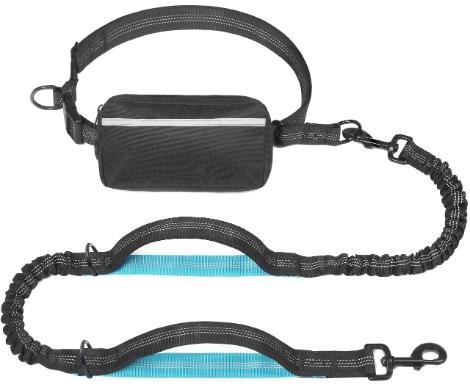
Product Highlights
- Running belt with dog leash attached
- Removable zipper pouch
- 2 shock absorbers in leash to prevent tugging
- Waist belt adjusts from 27″ to 48″
- 19 different colors available
- 2 sizes for small or large dogs
Pros & Cons
Pros
- Inexpensive
- Variety of colorways
- Built-in shock absorbers
- Reflective threading for night runs
- 2 handles to help lead dog
Cons
- Not a lot of storage capacity
- Reviews state belt isn't as long as they'd like
Bottom Line
If you're looking for a hands-free method of running with your dog, the iYoShop Hands Free Dog Leash is a great, inexpensive option. With shock absorbers to help prevent tugging between you and your dog, as well as a zipper pouch to store your phone and keys, you can focus on your running form with your dog beside you.
If you like to take your pup with you on your runs, this hybrid waist belt and dog leash makes the most sense for you. Instead of strapping on a running belt and holding a separate leash, you can hook the included leash onto the belt and go completely hands-free.
There’s two areas where the leash can stretch; these “shock-absorbers” help prevent tugging between you and your dog. The leash also has two handles on the leash, so you can manually control your dog when you need too: a closer one for traveling in a city, and a farther one for a more spacious area, like a park.
Performance editor Anthony O’Reilly, CPT, has been using it with his dog since finding it on TikTok, and enjoys it a lot. “I’ve tried similar belts that always tug a little too hard during longer walks, but with this I can use it for well over an hour and not feel anything,” he adds. “It’s also great for training my dog to not go off track while we’re running.”
The zipper pouch is on the smaller side, though, and there’s no place for any hydration or water bottles. Anthony also wishes the leash was just a little longer, so his dog could have a bit more lead. Still, this belt and leash combination is inexpensive, fits a lot of different waist sizes, and comes in a variety of colors, so we think you’ll like it.
| Material | Nylon |
| Weight | Not listed |
| Sizes | Medium for small dogs, large for big dogs (waist belt adjusts between 27″ and 48″ on both sizes) |
Best Hydration Running Belt: Amphipod Profile-Lite High-Five K-Pack
Good for: taking water with you without adding too much bulk
Best for Hydration
Amphipod Profile-Lite High Five-K Pack
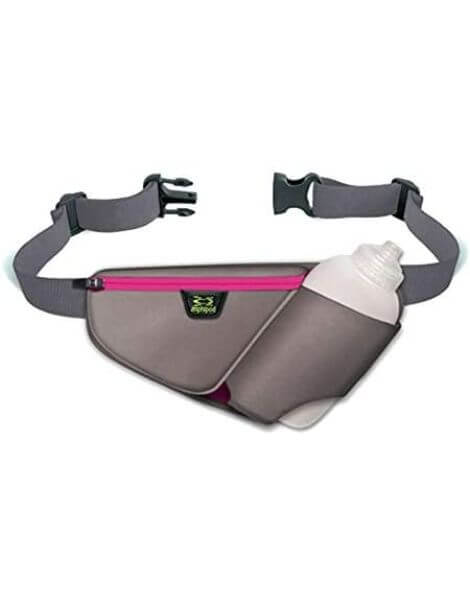
Product Highlights
- Running belt with insulated water bottle pouch
- Weather-resistant zippered pouch
- Included: Running belt and 16-oz water bottle
Pros & Cons
Pros
- Insulated water bottle pouch
- Available in multiple colors
- Zippered weather-resistant pouch
Cons
- Limited reviews
- Waist size not disclosed
- Adjustable strap too short according to reviews
Bottom Line
The Amphipod Profile-Lite High Five-K Pack has an insulated pouch to keep your water cool. Unfortunately, Amphipod doesn’t note the waist size range for their belt.
The Amphipod Profile-Lite High-Five K-Pack is a running waist pack that was built around hydration. It has a sloped sleeve that accommodates a 16-ounce water bottle and provides easy access mid-run. It’s also insulated so it can keep your drinks colder even when your body temperature rises, making it our pick for the best hydration belt for running.
Lauren took this running water belt trail running and on the road, and even with a full water bottle, it didn’t fall out of the pouch on the rugged terrain. There was also minimal bounce so it stayed comfortable.
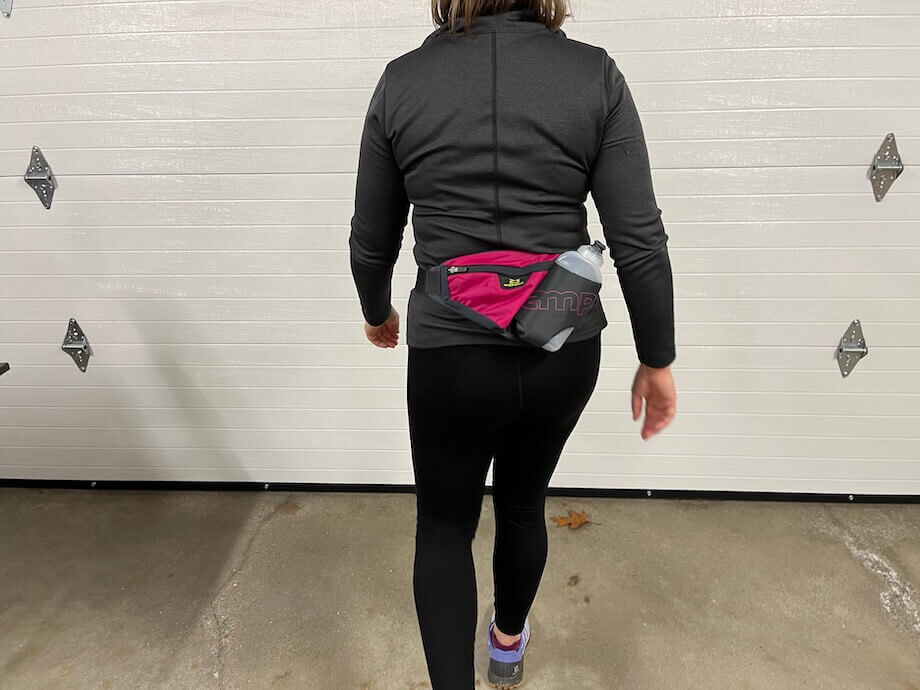
The look is basic, but Lauren says it’s more about function (and it isn’t ugly even though it’s a little bulkier than others she tested).
“This belt is simple but has it all: one pouch and one water bottle holder. The pouch fits my iPhone, but I have a minimalist case (this might not fit a big Otterbox style case). There is enough room for keys in there, too,” she says.
The main compartment is sweat- and weather-resistant, and there’s a vented mesh back panel that helps reduce hot spots. Another perk? The waist belt is fully adjustable, and while the adjustment does take a minute to do, the fit will work for most people.
| Material | Nylon, mesh |
| Weight | 0.34 kg (in box) |
| Sizes | One size fits most |
Other Running Belts We Researched
Lululemon Fast and Free Running Belt
Caroline Lubinsky, GGR product tester and self-proclaimed Lulu stan, really liked this running belt, but ultimately it didn’t make the list for two reasons: It had a weird fit and had to be pushed down right on top of the butt cheeks to feel secure, and the sizing isn’t very inclusive. It maxes out at a L/XL (and does run big, for the record), but it’s still pretty limited.
The Nathan Zipster is decent, but had some design issues that we couldn’t look past. Because it’s one-size-fits-most, the belt is really long. When adjusted, the extra slack just hangs there and flaps in the wind, which feels and sounds annoying, according to Nicole. She tried to tuck it in but it kept coming out. It also felt bulky compared to others she’s tried, but it does have good storage capacity so the trade-off could be worth it to you.
Fitletic Ultimate II Running Pouch
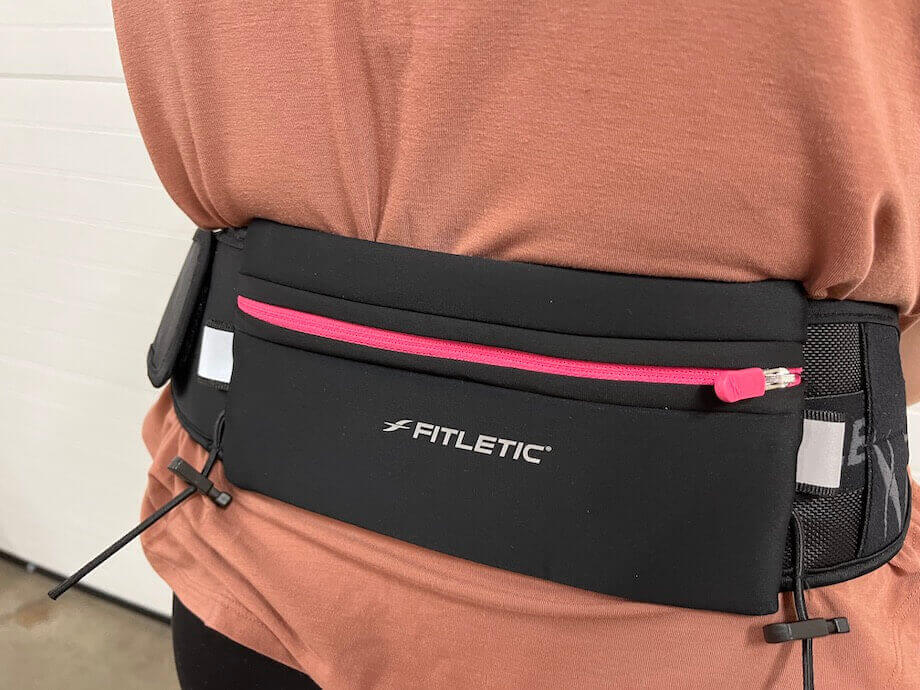
This running belt isn’t bad for a budget pick, but Lauren said it felt tight and uncomfortable around her hips. You can wear it around your waist to circumvent this issue, but we think there are better-fitting options out there. This one does have decent storage, though, and specialized loops to hold running fuel such as gel pouches.
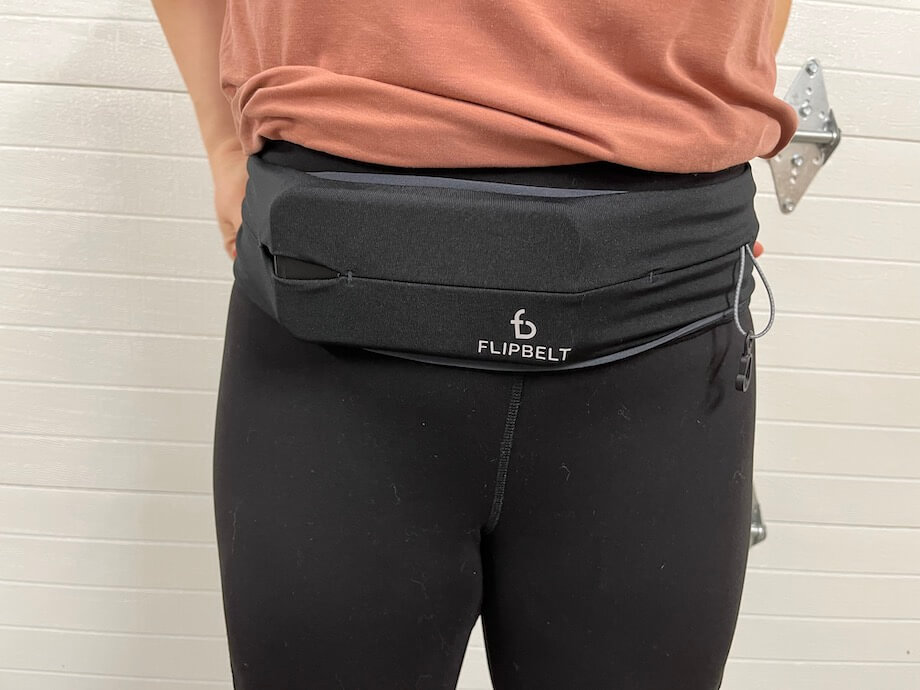
The FlipBelt Classic Running Belt is another okay option. If you’re looking for a minimalist (and inexpensive) belt, this could be a good pick for you. It has slits to hold your phone, money, and ID, but no zippers or clips for added security. It also has a slip-on design that makes it a little annoying to put on—since you can’t adjust it, you’ll want to double check to make sure you’re getting the right size.
How We Picked and Tested
Our testing always starts with extensive research. For this roundup, we looked at the most popular running belts from the most well-known brands. We also dug into some lesser known brands, making sure to consider a range of price points.
Once we narrowed our testing pool down, we strapped the belts on and got to running. We tested them with only a few items, like an ID and some cash, and loaded them up to their max capacity. If the belts came with bottle holders, we filled up the flasks for testing to see how they fared.
During our runs, we assessed fit, comfort, bounce, and functionality. We actually drank from the water bottles to see how easy they were to remove and return to their dedicated pouches. We also considered how easy the belts were to put on and take off. Some of them have clips that you can quickly wrap around your waist. Others are made of a stretchy material that you step into and pull up.
After about two weeks of testing, we rated each running belt on 12 factors, including price, purchasing/delivery, storage capacity, clasps and closures, appearance, fit, durability, performance and customer reviews/satisfaction. The belts that ended up with the highest average rating are the ones that made our list.
Benefits of Running Belts
Running belts serve double-duty. They make your run completely hands-free so you can focus on your form (while still listening to your Spotify playlist). “They also put necessities, like water, protein bars, and energy gels right at your fingertips so you can fuel up during longer runs,” Amanda says.
There are running vests too—or you could just carry a backpack—but running belts have a more minimalist design. They don’t trap heat or weigh you down, so if you have fewer things to carry, you can do it without adding too many extra layers.
Buying Guide (What to Look for in a Running Belt)
When shopping for a running belt, the fit, amount of storage space and material type are among the top considerations. You also want to think about whether you want hydration capabilities or not.
Adjustability/Fit
Adjustability and fit are two of the most important things to think about. If your belt is too tight or falling off as you run, you’re not going to have a good time.
Some belts are one size fits most, with adjustable buckles and straps that give you a more customized fit. Others come in specific sizes and rely on spandex for compression. Either type can work, but if you choose a non-adjustable belt, just make sure you’re extra diligent about measuring your dimensions to find a snug fit.
Storage Space
The main purpose of a running belt is to store your stuff, so you need to make sure the one you pick is up to the task. If you want to carry your phone, an ID, and some snacks or hydration packs with you, you’ll need more space than someone who likes to run with fewer personal items. If you have a large phone, make sure the phone pouch is actually large enough to accommodate it (in our testing experience, some of them get a little tight for bigger iPhones).
When considering storage space, also think about the overall weight—you want it to hold all your stuff without weighing you down too much—as well as how the weight is distributed. The larger pockets should be in the center and any hydration pouches should sit on both sides, or in the middle, to help balance out the load.
Material Type
Since a running belt will essentially be another layer on your body, you want to make sure you’re choosing a breathable material that can help regulate heat instead of trapping it. Spandex and nylon combos are a popular option, since they’re often water-resistant too. You can also look for additional features, like mesh backing or pockets that allow air to flow through as your body temperature heats up.
The fabric can also affect how bulky the running belt feels—nylon and neoprene are usually very thin yet still durable. They sit closer to the body and don’t add a lot of bulk or weight to your run.
Hydration Capabilities
Hydration capabilities aren’t a must-have in a regular running belt (you can get a separate hydration vest for that), but they’re a nice-to-have for longer runs or if you want to go completely hands-free. Some belts have extra pouches or loops that accommodate water flasks, and some belts even come with the bottles so you don’t have to worry about finding one that fits. If this is important to you, make sure the belt you choose can accommodate.
Best Running Belts FAQs
Are Running Belts Worth It?
If you want to take some essentials with you on your run, but don’t want to carry them, a good jogging belt is absolutely worth it. Compared to other running gear, they’re a pretty minimal investment—the highest priced model on our list is about $60—yet they’re built to last through many runs.
Do Running Belts Slow You Down?
The right running belt won’t slow you down on race day. These belts are really lightweight to begin with, weighing only a handful of ounces. The pouches are also evenly distributed to help spread out the load when you actually fill them with your stuff.
Is An Armband Or Belt Better For Running?
It depends what you’re trying to accomplish. Armbands are typically smaller, so they’ll hold your phone and maybe one other small thing. Belts can accommodate more, including your keys and a Camelbak or other water bottle, depending on how they’re designed. If you’re going for a short run and you just want some tunes to power you through, an armband is probably sufficient. But if you want to take some extra essentials and hydration on a longer run, you probably need a belt.


